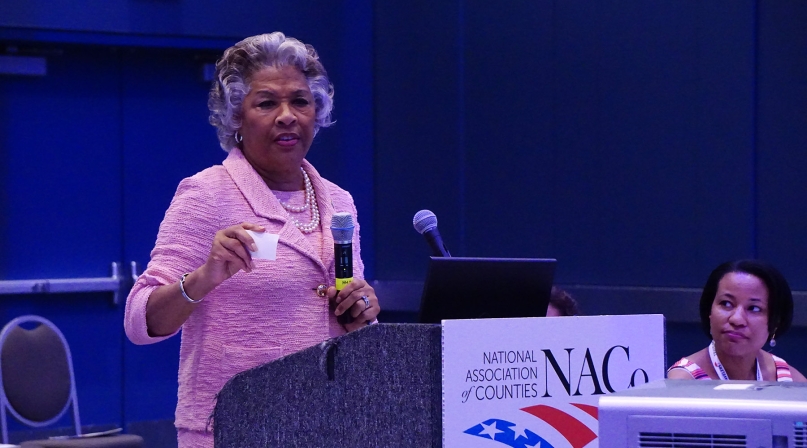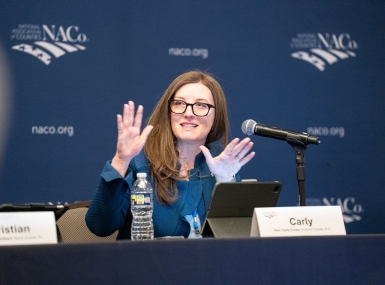Day One at the 2017 NACo Annual Conference
Upcoming Events
Related News

Fifteen-hundred county officials from across the country are expected to participate in NACo’s 2017 Annual Conference and Exposition, held this year in Franklin County, Columbus, Ohio.
The formal opening is a day away, yet agendas are already full with steering committee meetings, mobile tours and special forums and events.
The association's steering committees meet today to discuss the merits of more than 100 suggested policy resolutions. Many of their meetings also feature presentations from policy area experts or federal agency officials.
Also on the schedule: the first of several County Talks — short 20 minute–30 minute presentations, scattered throughout the course of the conference, that showcase ideas from corporations to help counties meet nagging challenges.
In addition:: The Next Generation Network holds its traditional service project: This time stuffing 350 backpacks with toiletries and games for children, teens and caregivers at the Nationwide Children’s Hospital in Columbus.
Watch this space for more updates on the day’s events.
ICE reaches out to county officials
Immigration and Customs Enforcement (ICE) reached out to county officials Friday during a discussion of the enforcement of the nation’s immigration laws, at NACo’s annual conference in Franklin County, Ohio.
“We seek to cooperate in all possible ways, our people want to work with your people,” said John Barsa, acting assistant secretary, Office of Partnerships and Engagement, U.S. Department of Homeland Security.
At Friday’s meeting of NACo’s Justice and Public Safety Steering Committee, Hood River County, Ore. Commissioner Karen Joplin said her county was discontinuing its contract to house ICE detainees at a regional jail due to a lack of support from the federal government and protests from residents. “What we’re experiencing is a lack of cooperation from ICE,” she said.
“People are very passionate about this, but if laws on the books aren’t being accepted, we need to go back to our leaders — we follow policy to a T,” said Rebecca Adducci, field office director for ICE in Michigan and Ohio, who drove to the conference from her office in Wayne County, Mich.
“We’re asking everyone to take a deep breath,” Barsa said. He encouraged county officials to make contact with their local ICE representatives at www.ice.gov. “Work with your local ICE person.”
Battling childhood poverty
NACo First Vice President Roy Charles Brooks, a commissioner from Tarrant County, Texas, plans to make combating childhood poverty his initiative when he becomes president of the association, he said Friday.
More than one in five children live in poverty in the United States, according to the U.S. Census Bureau.
“It’s time to address this devastating national problem,” Brooks told members of NACo’s Human Services and Education Steering Committee Friday morning at the association’s annual conference in Franklin County, Ohio.
“Poverty is not just a suburban, urban or rural problem,” Brooks noted. “You’ll find even in our most affluent areas there are pockets of poverty.”
More information about the initiative will be formally introduced at the conference as Brooks takes the reins in the coming days.
Tooth decay’s impact on..report cards?
Most people probably don’t equate cavities with education, but NACo members Friday learned that poor dental health can often lead to truancy, school attendance issues and financial troubles for families.
The Oregon Community Foundation launched a massive effort several years ago to offer dental programs to kids in local schools, conference speaker Mark Mulvihill, superintendent of the InterMountain Education Service District in Oregon, told NACo members. The program includes everything from exams to sealants to tooth brush kits.
By helping children with dental health, “you can get the kids to school, healthy and ready to learn,” Mulvihill said. “It’s our job to get these kids to the finish line.”
Dental health was featured in last month’s issue of American Journal of Public Health. Oral disease remains the most chronic condition in children and adults, Dr. Louis Sullivan, former secretary of the Department of Health and Human Services, wrote.
Mulvihill spoke at NACo’s Human Services and Education Steering Committee meeting at the association’s annual conference.
County Cannabis Roundtable
Whatever their constituencies think, morally, about cannabis, county officials are finding themselves forced to set land use policy regarding its cultivation, lest they put themselves at a regulatory disadvantage.
The County Cannabis Roundtable assembled a cast of county officials who have dealt with the process of cannabis regulation in Washington state, Oregon and California to share their experiences and advice.
James Gore, a Sonoma County, Calif. supervisor, pointed out that many of the crop’s growing hotspots were once-thriving timber regions.
“We are dealing with a problem that has been ubiquitous in our communities for 30 years, we’re trying to bring it into the light,” he said.
With 28 states and the District of Columbia having passed some form of cannabis legalization, “it’s becoming de facto legal overall, so you’d better be ready to handle it,” he said.
“In 30 years, this is the most chaotic mess I’ve ever seen,” said Bill Hall, a Lincoln County, Ore. commissioner. When counties attempt to regulate land use for cannabis growing operations, they should “be prepared for chaos, be prepared for unintended consequences.”
And counties have to come in with a clear plan for what they want.
“You’re going to find yourself in zoning regulatory land use areas dealing with a lot of smart businesspeople,” he said.
Rob Bovett, legal counsel for the Association of Oregon Counties, advised counties to dig in their heels when state policy is set, because counties are facing a must-win scenario for maintaining local control over zoning.
“I guarantee there is nobody else who will promote local control,” he said. “Don’t let sheriffs or chiefs of police run away from the table, because the industry will run right over them.”
Obie O’Brien, Kittitas County Wash. “If you don’t seize control from the beginning, you will never get it back.”
Rex Bohn, a supervisor in Humboldt County, Calif., suggested that studying the history of prohibition was a good preview for some of the issues and struggles ahead in the legalization of cannabis.
Congresswoman: The power of partnerships
Members of Congress should be required to meet quarterly with county officials from their district, Rep. Joyce Beatty (D-Ohio) told NACo members Friday.
“How do you like that? I’m very serious about that,” she told members of the association’s Community, Economic and Workforce Development Committee Friday afternoon.
When county officials meet with members of Congress or federal agencies, they need to be ready with examples of what works, she said. “We need more stories. We have to tell them positive stories, not just negative. I want us to change the script. What are we advocating for and what are the changes we’re making?”
“You know the drill,” she said. “We sit in our federal bubble and I know you watch CNN, FOX…you’re watching and it probably seems like things aren’t going well. But there’s another side you don’t see. You don’t see when we partner. When the president’s budget zeroed out CDBG [Community Development Block Grant Program]. Republicans and Democrats in Congress stood up and said ‘no.’”
“When I went to Washington five years ago,” she said, “I had no idea the value of partnerships.”
Transportation Steering Committee
Facing an inventory of 115 bridges, Northampton County, Pa. Executive John Brown didn’t like the options for repairing them.
“Traditionally, we’d follow the transportation improvement program, we’d have to apply at to the state department of transportation for federal and state money,” he told the Transportation
Steering Committee. “But we’d be competing with PennDOT and other 66 counties for projects.
There were limitations for federal funding that would limit us, and that timeline was roughly 4–6 years from start to finish with a bridge.”
Over that time, material and labor costs increase, and he saw, at best, a chance to do one or two bridge projects each year.
“It’s not a very cost-effective process for keeping bridges current,” he said.
So the county struck out on its own, forming a public-private partnership through its general purpose authority (necessary under a state law to contract with private companies) to which contractors submit bids directly, as a group, rather than the county individually hiring architects, engineers and other professionals, and those contractor groups assume risk for project delays, once the burden of the county.
“By not going for state funding through the TIF program, it un-handcuffed us,” Brown said. “We saved about 30 percent on 28 bridge rehabilitations and five replacements, and we didn’t have to jump through hoops with the federal and state regulations.”
Attachments
Related News

NACo members explore adding a midsize county caucus
If the NACo Board approves it, a midsize county caucus would join LUCC and RAC.

2025 NACo Legislative Conference Coverage
Follow along with County News during NACo’s Legislative Conference: policy steering committees, General Session speakers, educational workshops and more.

NACo kicks off 2025 Legislative Conference
County officials are addressing workforce gaps, land use, intergovernmental partnerships, disaster response and preparedness, federal regulations and the future of artificial intelligence at NACo’s 2025 Legislative Conference.